Hi, as promised some time ago here finally comes my short review of these two Carters. I have first bought the Funayuki and the main purpose for the knife is to take care of most veggie work at home. The Muteki was bought later and there the intended purpose is to be used as travel cooking knife that should handle wide range of tasks. Here are my (to be noticed - amateur) views on how these two knives perform. So, here they are:
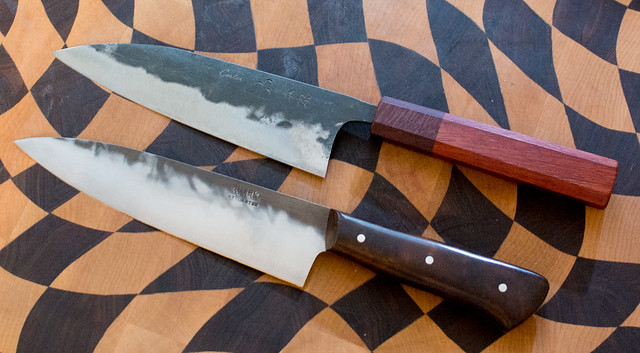
Already first look tells you that even thous the cutting edge of these two differs by only few mm, they are actually quite different knives. But let me start with few basic facts:
Muteki
- weight: 147 g
- blade length: 172 mm
- blade height at the heel: 41 mm
- blade thickness at the heel: 2.1 mm
- blade thickness 1/2 way towards the tip: 1.7 mm
- blade thickness 1cm from the tip: 1.0mm
- white #1 clad with 420 stainless
Funayuki
- weight: 114 g
- blade length: 167 mm
- blade height at the heel: 47 mm
- blade thickness at the handle: 3.8 mm
- blade thickness at the heel: 2.9mm
- blade thickness 1/2 way towards the tip: 1.6mm
- blade thickness 1cm from the tip: 0.9 mm
- white #1 clad with iron
As you can see - the Muteki has slightly thicker blade and is also slightly thicker behind the edge - though certainly not thick. It needs to be noticed that Carter knives vary in thickness, so when buying just keep an eye on the blade thickness. Both knives have quite comparable grind though. The higher weight of the Muteki comes mostly from the full tang construction and heavy ironwood.
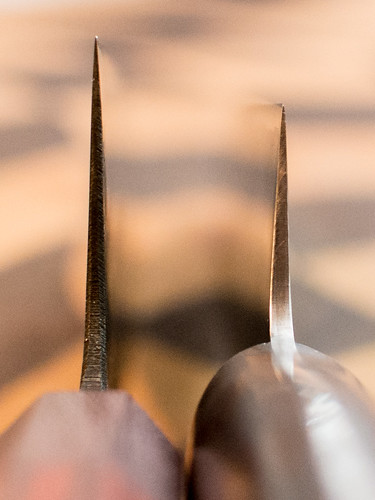
The choil is not particularly rounded on any of the two, but feels less sharp on the funayuki. Still - with the blade height of the Muteki it is not going to be used particularly often with pinch grip, so it is less relevant.
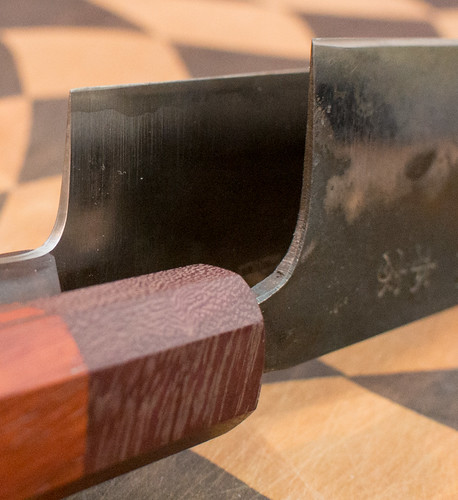
In use the differences between these two knives become quickly apparent. The funayuki has taller blade with relatively flat profile. It excels around vegetables and offers itself to chop-cutting. Since it has WA handle that does not seem particularly heavy it has slightly forward weight distribution which supper style of cutting. It has also enough knuckle space and long neck - pinch grip is very natural.
The Muteki on the other side has western handle which together with few mm less blade height just clears your knuckles, but not with every grip. The handle is relatively small since western knives do not have long 'neck' as WA knives do - the blade does not feel longer compared to funayuki. Hammer grip seems to work best. The blade has more belly towards the tip so slicing or push cutting (when you cut closer to the heel and keep the tip near the cutting board) works very well.
47 mm blade height together with WA handle gives you ample room for your knuckles.

This is about as much of knuckle clearance as you are going to get with 41mm blade height and western handle. And I do not have particularly large hands.
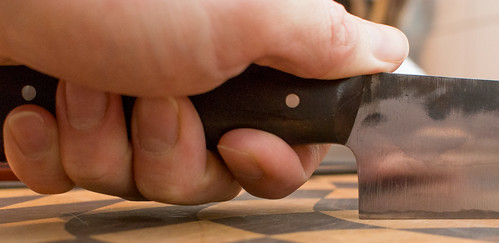
Handle size:
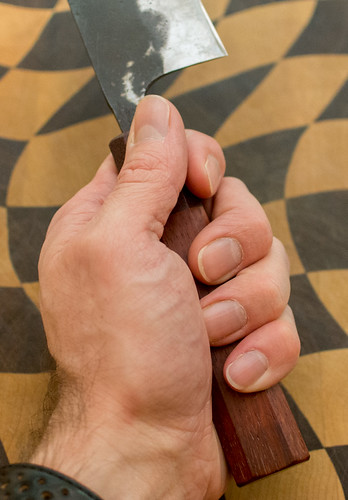
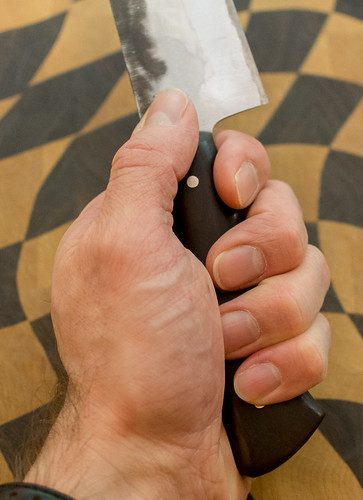
Since both knives have the same core steel with apparently the same heat treat, the edge holding is very comparable. I have not used Muteki enough yet to fully confirm that, so that is what I assume here. The edge holding with the funayuki is good enough for the home use. Even though that funayuki is my most used knife at home use it last around a month before I start to feel that it needs sharpening. Even then it still cuts well since it is so thin. However well has Carter figured out heat treat of white#1, it can not 'beat' super blue of my Masakage Koishi (which on all other accounts is not as refined as the Carter is), but it is definitely more than 'good enough'
One little observation - in spite the Muteki being a little thicker - the funayuki seems a little more stiff. On absolute scale I would say that the funayuki is a relatively stiff knife and the Muteki is 'normal'. I assume that the main reason for this is the difference in cladding.
The cladding & patina. Obviously - the stainless cladding of the Muteki leaves very little chance for rust to develop and the white steel has so far acquired nice patina what actually looks quite cool. The cladding on the funayuki is not quite as reactive as some other knives I had a chance to use (i.e. Kato Workhorse), but it is (not surprisingly) more reactive than the core steel. I wipe the knife when using it here and then, but do not go to any particular length to keep it patina free. The patina over time became relatively stable and I rarely see some effects of it while cutting and never had a food to get smelly - even when the knife was new.
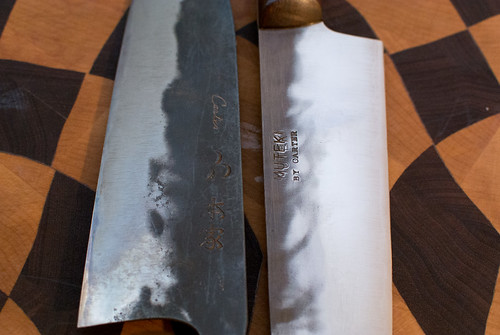
Hier a BW conversion to make the difference in finish more obvious.
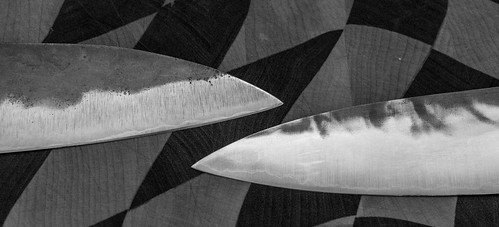
Sharpening - as you would expect - easy! Never started with coarser stone stone than my Gesshin 2000 - it just was not necessary. The same is true for the Muteki. Eve the light microchips I got once on the Funayuki (probably the edge bevel was too thin) could be removed with ease with the 2000 stone. Well - that, after all, is the advantage of white steel.
Fit and finish. Here is where it get interesting. The Funayuki have more forging to shape done and it is obvious when you look at the knife. The Muteki are cheaper also because there is more grinding which is faster. But the surface finish of the grinding actually looks smoother on the Muteki than on the Funayuki. Funayuki, to my taste, is finished a bit too rough. They could have been taken to finer grit. The bevels grinding of the edge seems well done on both knives. The handle on my Funayuki is perfect - both design and finish. The handle on the Muteki is well made, the pins are flush with the handle surface and the handle feels nice. It could use little finish around the edges, but nothing that would disturb me.
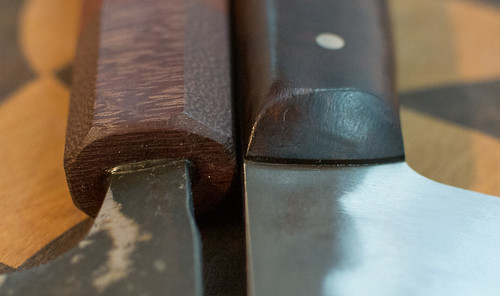

Hand slipped here a little.
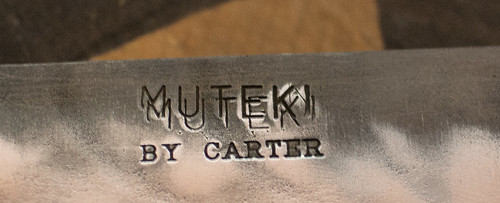
Summary:
As I mentioned at the very beginning - these two knives are similar in size, but different in use. I have bought the funayuki to be may main knife for vegetables, while I bought the Muteki to be the knife for cooking on the road - for that purpose the knife has optimal blade shape and size and the stainless cladding only adds to that. It just so happens that my wife quite likes the knife and so it will see even more use than originally intended.
One way or another - I have bought and later sold a few knives, but these two Carters are staying. I find that Carter knives do offer different options to what most other knife makers offer and are definitely worth the try if you find the design appealing.
Any questions left? Just ask


Already first look tells you that even thous the cutting edge of these two differs by only few mm, they are actually quite different knives. But let me start with few basic facts:
Muteki
- weight: 147 g
- blade length: 172 mm
- blade height at the heel: 41 mm
- blade thickness at the heel: 2.1 mm
- blade thickness 1/2 way towards the tip: 1.7 mm
- blade thickness 1cm from the tip: 1.0mm
- white #1 clad with 420 stainless
Funayuki
- weight: 114 g
- blade length: 167 mm
- blade height at the heel: 47 mm
- blade thickness at the handle: 3.8 mm
- blade thickness at the heel: 2.9mm
- blade thickness 1/2 way towards the tip: 1.6mm
- blade thickness 1cm from the tip: 0.9 mm
- white #1 clad with iron
As you can see - the Muteki has slightly thicker blade and is also slightly thicker behind the edge - though certainly not thick. It needs to be noticed that Carter knives vary in thickness, so when buying just keep an eye on the blade thickness. Both knives have quite comparable grind though. The higher weight of the Muteki comes mostly from the full tang construction and heavy ironwood.

The choil is not particularly rounded on any of the two, but feels less sharp on the funayuki. Still - with the blade height of the Muteki it is not going to be used particularly often with pinch grip, so it is less relevant.

In use the differences between these two knives become quickly apparent. The funayuki has taller blade with relatively flat profile. It excels around vegetables and offers itself to chop-cutting. Since it has WA handle that does not seem particularly heavy it has slightly forward weight distribution which supper style of cutting. It has also enough knuckle space and long neck - pinch grip is very natural.
The Muteki on the other side has western handle which together with few mm less blade height just clears your knuckles, but not with every grip. The handle is relatively small since western knives do not have long 'neck' as WA knives do - the blade does not feel longer compared to funayuki. Hammer grip seems to work best. The blade has more belly towards the tip so slicing or push cutting (when you cut closer to the heel and keep the tip near the cutting board) works very well.
47 mm blade height together with WA handle gives you ample room for your knuckles.

This is about as much of knuckle clearance as you are going to get with 41mm blade height and western handle. And I do not have particularly large hands.

Handle size:


Since both knives have the same core steel with apparently the same heat treat, the edge holding is very comparable. I have not used Muteki enough yet to fully confirm that, so that is what I assume here. The edge holding with the funayuki is good enough for the home use. Even though that funayuki is my most used knife at home use it last around a month before I start to feel that it needs sharpening. Even then it still cuts well since it is so thin. However well has Carter figured out heat treat of white#1, it can not 'beat' super blue of my Masakage Koishi (which on all other accounts is not as refined as the Carter is), but it is definitely more than 'good enough'
One little observation - in spite the Muteki being a little thicker - the funayuki seems a little more stiff. On absolute scale I would say that the funayuki is a relatively stiff knife and the Muteki is 'normal'. I assume that the main reason for this is the difference in cladding.
The cladding & patina. Obviously - the stainless cladding of the Muteki leaves very little chance for rust to develop and the white steel has so far acquired nice patina what actually looks quite cool. The cladding on the funayuki is not quite as reactive as some other knives I had a chance to use (i.e. Kato Workhorse), but it is (not surprisingly) more reactive than the core steel. I wipe the knife when using it here and then, but do not go to any particular length to keep it patina free. The patina over time became relatively stable and I rarely see some effects of it while cutting and never had a food to get smelly - even when the knife was new.

Hier a BW conversion to make the difference in finish more obvious.

Sharpening - as you would expect - easy! Never started with coarser stone stone than my Gesshin 2000 - it just was not necessary. The same is true for the Muteki. Eve the light microchips I got once on the Funayuki (probably the edge bevel was too thin) could be removed with ease with the 2000 stone. Well - that, after all, is the advantage of white steel.
Fit and finish. Here is where it get interesting. The Funayuki have more forging to shape done and it is obvious when you look at the knife. The Muteki are cheaper also because there is more grinding which is faster. But the surface finish of the grinding actually looks smoother on the Muteki than on the Funayuki. Funayuki, to my taste, is finished a bit too rough. They could have been taken to finer grit. The bevels grinding of the edge seems well done on both knives. The handle on my Funayuki is perfect - both design and finish. The handle on the Muteki is well made, the pins are flush with the handle surface and the handle feels nice. It could use little finish around the edges, but nothing that would disturb me.


Hand slipped here a little.

Summary:
As I mentioned at the very beginning - these two knives are similar in size, but different in use. I have bought the funayuki to be may main knife for vegetables, while I bought the Muteki to be the knife for cooking on the road - for that purpose the knife has optimal blade shape and size and the stainless cladding only adds to that. It just so happens that my wife quite likes the knife and so it will see even more use than originally intended.
One way or another - I have bought and later sold a few knives, but these two Carters are staying. I find that Carter knives do offer different options to what most other knife makers offer and are definitely worth the try if you find the design appealing.
Any questions left? Just ask





